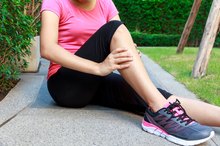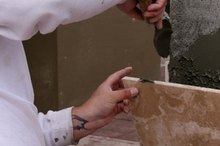Fluid on Elbow Symptoms
Fluid on the elbow is a condition known as elbow bursitis or olecranon bursitis (or sometimes “popeye elbow”) 1. The bursa is a lubricated sac located between the tip or bend of the elbow and the overlying skin. It helps reduce the friction between bones and skin, muscles or tendons during movement. Injury or infection can cause the bursa to become irritated, inflamed and filled with fluid or pus, leading to a number of bothersome symptoms.
If you are experiencing serious medical symptoms, seek emergency treatment immediately.
Inflammation
According to the American Academy of Orthopedic Surgeons, swelling is often one of the first symptoms of fluid on the elbow, or olecranon bursitis 12. Acute or chronic irritation or infection can cause fluid to increase inside of the bursa sac. As this happens, it causes swelling on the back of the elbow. Because of the folds of loose skin on the back of the elbow, swelling may go unnoticed for some time. As the fluid builds up, the inflammation increases and may appear as a "goose egg" over the tip of the elbow bone. In some cases, the bursa can grow so large that it restricts full movement of the elbow. Chronic inflammation caused by repeated injury or recurring infections can lead to the thickening of the folds of tissue of the bursa. The thick tissue can sometimes be felt beneath the skin; it may feel like nodules or small lumps, or as if there is something floating around in the area.
- According to the American Academy of Orthopedic Surgeons, swelling is often one of the first symptoms of fluid on the elbow, or olecranon bursitis 1.
- As the fluid builds up, the inflammation increases and may appear as a "goose egg" over the tip of the elbow bone.
Pain and Tenderness
What Causes Fluid on the Elbow?
Learn More
Some people may develop inflammation on the back of the elbow that causes no pain; however, others may experience slight to severe pain at the tip of the elbow. The elbow can become so tender that it is difficult to put it down on a table or other surface. Extending or retracting the elbow may be especially painful.
Infection
Infection caused by injury to the elbow or by a superficial skin infection that spreads down to the olecranon bursa can lead to more serious symptoms that affect the whole body. An abscess (pus-filled lesion) may form on the elbow, and the bursa can fill with pus instead of fluid. The area around the elbow may become red, streaked, hot and very tender to the touch. As the body tries to fight off the infection, the person may also develop a fever and chills. Without prompt treatment, the abscess can start to drain and seep pus. The infection may spread to other parts of the arm or body, so people who experience any signs of infection should seek prompt treatment to avoid serious complications.
- Infection caused by injury to the elbow or by a superficial skin infection that spreads down to the olecranon bursa can lead to more serious symptoms that affect the whole body.
- An abscess (pus-filled lesion) may form on the elbow, and the bursa can fill with pus instead of fluid.
Related Articles
References
- Cigna: Olecranon Bursitis (Popeye Elbow)
- American Academy of Orthopedic Surgeons: Elbow (Olecranon) Bursitis
- Orthopaedic Surgery NYC: Olecranon Bursitis
- Taylor SA, Hannafin JA. Evaluation and Management of Elbow Tendinopathy. Sports Health. 2012;4(5):384-393. doi:10.1177/1941738112454651
- Khodaee M. Common Superficial Bursitis. Am Fam Physician. 2017;95(4):224-231.
- Hubbard MJ, Hildebrand BA, Battafarano MM, Battafarano DF. Common Soft Tissue Musculoskeletal Pain Disorders. Prim Care. 2018;45(2):289-303. doi:10.1016/j.pop.2018.02.006
- Bracilovic A. Septic Bursitis. Veritas Health, LLC. Updated November 21, 2019.
- Blackwell JR, Hay BA, Bolt AM, Hay SM. Olecranon bursitis: a systematic overview. Shoulder Elbow. 2014;6(3):182-190. doi:10.1177/1758573214532787
- InformedHealth.org. Bursitis: Overview. Cologne, Germany: Institute for Quality and Efficiency in Health Care (IQWiG); 2006.
- InformedHealth.org. How can bursitis be treated? Cologne, Germany: Institute for Quality and Efficiency in Health Care (IQWiG); 2006.
- Patel J, Girishkumar, Mruthyunjaya, Rupakumar CS. Bilateral Olecranon Bursitis - A Rare Clinical presentation of Calcium Pyrophosphate Crystal Deposition Disease. J Orthop Case Rep. 2014;4(1):3-6. doi:10.13107/jocr.2250-0685.137
- Lockman L. Treating nonseptic olecranon bursitis: a 3-step technique. Can Fam Physician. 2010;56(11):1157.
- Sayegh ET, Strauch RJ. Treatment of olecranon bursitis: a systematic review. Arch Orthop Trauma Surg. 2014;134(11):1517-1536.
- Aaron DL, et al. "Four Common Types of Bursitis: Diagnosis and Management." J Am Acad Orthop Surg June 2011; 19:359-367.
Writer Bio
Based in New York City, Tricia Mangan began her writing career in 2001. She has co-authored a National Cancer Institute report and a number of research articles that have appeared in medical journals. Tricia holds a Master of Arts in clinical psychology from Stony Brook University and boasts diverse clinical, research and teaching experience.






